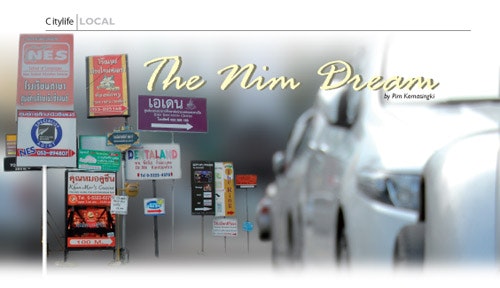Lecturers from Chiang Mai and Mae Jo universities as well as Rajamangala University of Technology Lanna, under the banner of the Chiang Mai Iam social initiative project, have come together to create a master plan for Nimmanhaemin Road. Though at this point a pipe dream, with the active support and participation of residents, relevant authorities and businesses in the area, their vision could turn into a reality.
“We believe in starting with the doable, that is why we are currently focusing on sois 17 and 19 (Sai Nam Peung), as they both involve a nice mix of small businesses and residences,” said Assoc. Prof. Dr. Pranom Tunsukanan, Vice Dean at Mae Jo University and head of research project. “Simple measures such as encouraging homes and businesses to plant trees and tidy their road front, inviting clusters of businesses to come together – as they have on Soi 1 – to create attractive signposts for all, clearing of pavement space…these are all things we can start with. We can even offer awards for most attractive or visually conscience business, using social sanction or social support to encourage or deter.”
More ambitious proposals include combating noise pollution which is endemic to the area, and one of the hardest to tackle due to the influence and power of many pub businesses; parking issues which could be solved if parking along Nimmanhaemin was banned altogether, and parking areas created on Prasertland or at the old Fah Thani theatre, with electric busses shuttling people along the road; creating public spaces with benches, trees and even public art.
“Nimmanhaemin is not a traditional community,” said Kanokwan Kotchasee of Rajamangala University of Technology Lanna, another member of the group. “This is both a drawback and an advantage. There is no temple or old village community to come together in support or protest. Many people have the will to change, but it is hard to organise with so many varying factors and interest groups. I think that the majority will jump on board in support, but some of the bigger businesses will be harder to cajole.”
“Basically we need to involve not only those directly affected in the area, but the traffic police, the highway department, city planning division, architects’ associations, the municipality, businesses involved and residents, said Assoc. Prof. Dr. Pranom.
Still in its infancy, this group are regularly holding meetings where residents, businesses, the media and any other interested parties can attend. If anyone is interested in becoming involved or learning more, please contact info@chiangmaicitylife.com and we shall forward your email to the relevant persons.
